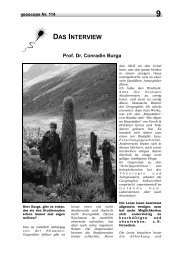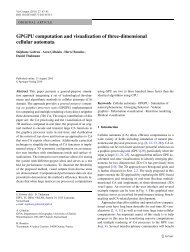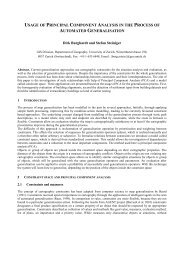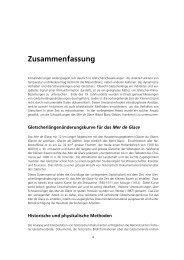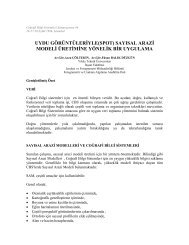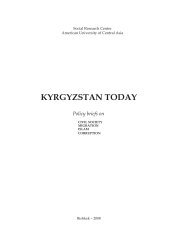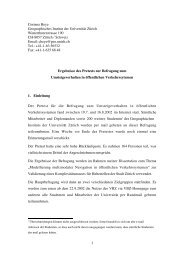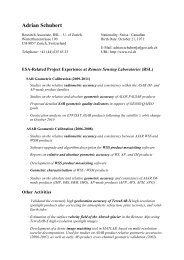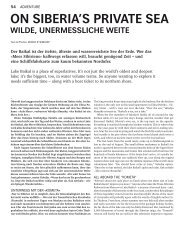Pedogenesis of Chernozems in Central Europe — A review
Pedogenesis of Chernozems in Central Europe — A review
Pedogenesis of Chernozems in Central Europe — A review
You also want an ePaper? Increase the reach of your titles
YUMPU automatically turns print PDFs into web optimized ePapers that Google loves.
Abstract<br />
<strong>Pedogenesis</strong> <strong>of</strong> <strong>Chernozems</strong> <strong>in</strong> <strong>Central</strong> <strong>Europe</strong> <strong>—</strong> A <strong>review</strong><br />
Eileen Eckmeier a,⁎ , Renate Gerlach b , Ernst Gehrt c , Michael W.I. Schmidt a<br />
a University <strong>of</strong> Zurich, Department <strong>of</strong> Geography, W<strong>in</strong>terthurerstrasse 190, 8057, Zurich, Switzerland<br />
b Landschaftsverband Rhe<strong>in</strong>land, Rhe<strong>in</strong>isches Amt für Bodendenkmalpflege, Endenicher Str. 133, 53115 Bonn, Germany<br />
c Niedersächsisches Landesamt für Bodenforschung, Stilleweg 2, 30655, Hannover, Germany<br />
Received 23 August 2005; received <strong>in</strong> revised form 30 August 2006; accepted 24 January 2007<br />
Available onl<strong>in</strong>e 3 April 2007<br />
S<strong>in</strong>ce Dokuchaev's <strong>in</strong>vestigations <strong>of</strong> Russian <strong>Chernozems</strong>, <strong>Central</strong> <strong>Europe</strong>an <strong>Chernozems</strong> were established as steppe soils, with their<br />
pedogenesis dom<strong>in</strong>ated by humus accumulation as a result <strong>of</strong> dry cont<strong>in</strong>ental climate and steppe vegetation, with carbonaceous parent material and<br />
bioturbation as other prerequisites. The WRB-FAO classification def<strong>in</strong>ed <strong>Chernozems</strong> by their morphological characteristics, but was biased by<br />
the climo-genetic formation model. However, the assumption that modern <strong>Central</strong> <strong>Europe</strong>an <strong>Chernozems</strong> are relics <strong>of</strong> steppe soils conflicts with<br />
palaeobotanical evidence from an early reforestation that started <strong>in</strong> the Late Glacial, and also with pedological studies that dated Chernozem<br />
formation to the Early Holocene.<br />
In this <strong>review</strong> we compile the most important literature on pedogenesis <strong>of</strong> <strong>Central</strong> <strong>Europe</strong>an <strong>Chernozems</strong> s<strong>in</strong>ce the 1920s, accord<strong>in</strong>g to the soil<br />
form<strong>in</strong>g factors climate, time, vegetation, relief and man.<br />
Our <strong>review</strong> demonstrates that there is no consensus on the factors controll<strong>in</strong>g the formation, conservation and degradation <strong>of</strong> <strong>Central</strong> <strong>Europe</strong>an<br />
<strong>Chernozems</strong> <strong>in</strong> published literature. We found that (1) no absolute time <strong>of</strong> formation could be stated so far, and that (2) <strong>Central</strong> <strong>Europe</strong>an<br />
<strong>Chernozems</strong> formed not only under steppe but also under forest vegetation; (3) the spatial distribution <strong>of</strong> <strong>Chernozems</strong> and Phaeozems did not<br />
correlate with climate conditions or topographic position, and (4) until now no other factors were considered to be responsible for Chernozem<br />
development. Recent studies showed that these unknown factors could <strong>in</strong>clude anthropogenic activity and vegetation burn<strong>in</strong>g as they could form<br />
black soils or strongly affect the composition <strong>of</strong> soil organic matter.<br />
We concluded that not all soils classified as <strong>Chernozems</strong> <strong>in</strong> <strong>Central</strong> <strong>Europe</strong> are steppe soils and thus, as they do not necessarily reflect past<br />
climate, the classification may be mislead<strong>in</strong>g.<br />
© 2007 Elsevier B.V. All rights reserved.<br />
Keywords: Chernozem; Phaeozem; <strong>Central</strong> <strong>Europe</strong>; <strong>Pedogenesis</strong>; Literature <strong>review</strong><br />
1. Introduction<br />
S<strong>in</strong>ce Vassilij V. Dokuchaev's <strong>in</strong>vestigations <strong>in</strong> Russia,<br />
<strong>Chernozems</strong> were def<strong>in</strong>ed as steppe soils, with their pedogenesis<br />
dom<strong>in</strong>ated by the soil-form<strong>in</strong>g factors <strong>of</strong> dry cont<strong>in</strong>ental<br />
climate and steppe vegetation, with carbonaceous parent<br />
material, ma<strong>in</strong>ly loess, and bioturbation as other prerequisites<br />
(Dokuchaev, 1883, 1889). Dokuchaev's results for the Russian<br />
<strong>Chernozems</strong> were transmitted to <strong>Central</strong> <strong>Europe</strong>an <strong>Chernozems</strong><br />
⁎ Correspond<strong>in</strong>g author.<br />
E-mail address: eckmeier@geo.unizh.ch (E. Eckmeier).<br />
0016-7061/$ - see front matter © 2007 Elsevier B.V. All rights reserved.<br />
doi:10.1016/j.geoderma.2007.01.009<br />
Geoderma 139 (2007) 288–299<br />
www.elsevier.com/locate/geoderma<br />
(e.g. by Hohenste<strong>in</strong>, 1919) and his def<strong>in</strong>ition was assumed to be<br />
universally valid for Eastern and <strong>Central</strong> <strong>Europe</strong>, although it<br />
was deduced from Russian soils.<br />
But a comparison <strong>of</strong> the results <strong>of</strong> several studies concern<strong>in</strong>g<br />
the formation <strong>of</strong> <strong>Central</strong> <strong>Europe</strong>an <strong>Chernozems</strong> to Dokuchaev's<br />
def<strong>in</strong>ition <strong>of</strong> a Chernozem as a steppe soil showed that there are<br />
obvious discrepancies. By def<strong>in</strong>ition, <strong>Chernozems</strong> should be<br />
zonal soils, preserved under cont<strong>in</strong>ental steppe conditions.<br />
However, cont<strong>in</strong>ental climate occurred dur<strong>in</strong>g the Late Glacial<br />
(c. 15000–11500 BP) but there is no evidence for the presence<br />
<strong>of</strong> <strong>Chernozems</strong> <strong>in</strong> <strong>Central</strong> <strong>Europe</strong> <strong>in</strong> the Late Glacial<br />
(Rohdenburg and Meyer, 1968; Ik<strong>in</strong>ger, 1996). First evidence<br />
for fully developed <strong>Chernozems</strong> orig<strong>in</strong>ate from the Early
Holocene (c. 11500–5500 BP; Pre-Boreal to Atlantic) when<br />
warmer climate and forest vegetation dom<strong>in</strong>ated the <strong>Central</strong><br />
<strong>Europe</strong>an loess-belt.<br />
The purpose <strong>of</strong> this <strong>review</strong> is to highlight the most important<br />
literature on <strong>Chernozems</strong> <strong>in</strong> <strong>Central</strong> <strong>Europe</strong> published s<strong>in</strong>ce the<br />
1920s. We did not discuss the Russian <strong>Chernozems</strong>, because<br />
this would exceed the limits <strong>of</strong> this paper. We also exluded black<br />
soils formed with a steady water supply, like Gleyic<br />
<strong>Chernozems</strong> and Gleyic or Stagnic Phaeozems. In this <strong>review</strong>,<br />
we want to discuss the follow<strong>in</strong>g questions: (1) What is the<br />
def<strong>in</strong>ition <strong>of</strong> <strong>Chernozems</strong>, and (2) where do we f<strong>in</strong>d them? (3)<br />
When did <strong>Central</strong> <strong>Europe</strong>an <strong>Chernozems</strong> form, and (4) is their<br />
formation bound to a certa<strong>in</strong> climate and vegetation? (5) Which<br />
factors control conservation and degradation <strong>of</strong> <strong>Chernozems</strong>?<br />
(6) Are there unconsidered factors that <strong>in</strong>fluence Chernozem<br />
formation or their soil properties?<br />
We focus on different soil form<strong>in</strong>g factors potentially<br />
dom<strong>in</strong>at<strong>in</strong>g the pedogenesis <strong>of</strong> <strong>Chernozems</strong> <strong>in</strong> <strong>Central</strong> <strong>Europe</strong>,<br />
i.e. time, vegetation, climate and, potentially overlooked so far,<br />
fire and man. We want to po<strong>in</strong>t out that there is no generally<br />
accepted consensus on the formation <strong>of</strong> <strong>Chernozems</strong> <strong>in</strong> <strong>Central</strong><br />
<strong>Europe</strong>.<br />
E. Eckmeier et al. / Geoderma 139 (2007) 288–299<br />
2. What is a Chernozem? Def<strong>in</strong>itions and systematics<br />
The World Reference Base for Soil Resources (FAO/ISRIC/<br />
ISSS, 1998) def<strong>in</strong>ed <strong>Chernozems</strong> as soils with mollic or chernic<br />
horizons <strong>of</strong> at least 20 cm and with a chrome <strong>of</strong> ≤2 for substrate<br />
f<strong>in</strong>er than sandy loam or ≤3.5 for sandy loam or coarser<br />
substrate, respectively. <strong>Chernozems</strong> should conta<strong>in</strong> concentrations<br />
<strong>of</strong> secondary carbonates start<strong>in</strong>g with <strong>in</strong> 50 cm <strong>of</strong> the<br />
lower limit <strong>of</strong> the A horizon but at least with<strong>in</strong> the top 200 cm,<br />
they should lack a petrocalcic horizon or secondary gypsum<br />
between a depth <strong>of</strong> 25 and 100 cm, and their diagnostic horizons<br />
are no other then argic, vertic or calcic. There should be no<br />
uncoated silt and sand gra<strong>in</strong>s on the structural ped surfaces.<br />
Usually, the dark mollic A horizon is situated on an argic or<br />
cambic B horizon. The mollic horizons are rich <strong>in</strong> organic<br />
matter (10–16%), are highly saturated with bases and react<br />
neutral. Typical features <strong>of</strong> <strong>Chernozems</strong> are the formation on<br />
mostly aeolian and carbonaceous sediments like loess, the<br />
occurrence <strong>in</strong> cont<strong>in</strong>ental climate under tall-grass vegetation<br />
that provides high above-ground biomass <strong>of</strong> about 1.0–1.5 t<br />
ha − 1 , and an <strong>in</strong>tense bioturbation shown by krotov<strong>in</strong>as (animal<br />
burrows) (FAO/ISRIC/ISSS, 1998; Driessen et al., 2001).<br />
Fig. 1. <strong>Central</strong> <strong>Europe</strong>an <strong>Chernozems</strong> and related soils as described <strong>in</strong> the German pedological literature. The Chernozem (‘Tschernosem’) has a dark mollic horizon<br />
and could have stagnic or gleyic properties. The latter do not appear <strong>in</strong> areas with lower water net balance, here secondary carbonates become more frequent. Increas<strong>in</strong>g<br />
precipitation and leach<strong>in</strong>g leads to the development <strong>of</strong> first Haplic, then Cambic and Luvic <strong>Chernozems</strong> and f<strong>in</strong>ally Luvic Phaeozems (‘Tschernosem–Parabraunerde’).<br />
Some soils have properties that fit to the Chernozem def<strong>in</strong>ition, with the exception that their mollic horizon is greyish and not dark brownish to black (‘Grauerden’;<br />
term is not recognised <strong>in</strong> the <strong>of</strong>ficial German classification). These grey soils can conta<strong>in</strong> secondary carbonates (calcic) or can have gleyic or stagnic properties and<br />
were assigned to the Phaeozems. Luvisols (‘Parabraunerde’) develop af ter stronger leach<strong>in</strong> g and translocation <strong>of</strong> clay.<br />
289
290 E. Eckmeier et al. / Geoderma 139 (2007) 288–299<br />
<strong>Chernozems</strong> can develop <strong>in</strong> to Phaeozems, and the characteristics<br />
<strong>of</strong> Phaeozems resemble those <strong>of</strong> <strong>Chernozems</strong>. They<br />
have a mollic horizon and a base saturation <strong>of</strong> at least 50%.<br />
They should not conta<strong>in</strong> secondary carbonates up to 100 cm<br />
depth and have no diagnostic horizons other than albic, argic,<br />
cambic or vertic. Compared to <strong>Chernozems</strong>, Luvic Phaeozems<br />
occur <strong>in</strong> more humid regions, have higher rates <strong>of</strong> leach<strong>in</strong>g and<br />
therefore lack carbonates. Argic B horizons seem to be relics<br />
from stronger leach<strong>in</strong>g and <strong>in</strong>dicate the development towards<br />
Luvisols (FAO/ISRIC/ISSS, 1998; Driessen et al., 2001). However,<br />
the soil map <strong>of</strong> the world mentions the subunit Calcaric<br />
Phaeozem with more then 2% CaCO3 (FAO-UNESCO, 1981).<br />
The def<strong>in</strong>itions <strong>of</strong> <strong>Chernozems</strong> and Phaeozems by FAO-WRB<br />
stress their morphology but were biased by the climo-genetical<br />
background. This makes it difficult to assign all <strong>Central</strong><br />
<strong>Europe</strong>an Chernozem subunits (e.g. for Germany described by<br />
Ad-hoc-AG Boden, 2005; see also Altermann et al., 2005)tothe<br />
FAO-WRB classification. The differences between the soil units<br />
described <strong>in</strong> the German pedological literature are expla<strong>in</strong>ed <strong>in</strong><br />
Fig. 1.<br />
Stagnic and Gleyic Phaeozems developed under different<br />
conditions than soils <strong>in</strong> steppe areas (Scheffer and Meyer,<br />
1965). However, the German def<strong>in</strong>ition <strong>of</strong> a ‘Schwarzerde’<br />
(black earth) subsumes soils with greyish to black (Chromab3.5,<br />
Value≤4) Axh horizons≥40 cm and either with secondary<br />
carbonates (‘Kalktschernosem’)orwithout(‘Tschernosem’). The<br />
term ‘Tschernosem’ <strong>in</strong>cludes not only Chernozem or Phaeozem<br />
subunits but also Kastanozems, Gleysols and Fluvisols and<br />
implies bioturbation as specific formation qualification (Ad-hoc-<br />
AG Boden, 2005). Despite these def<strong>in</strong>itions, the terms<br />
‘Schwarzerde’ and ‘Tschernosem’ were usually related to the<br />
appearance <strong>of</strong> steppe soil relics <strong>in</strong> <strong>Central</strong> <strong>Europe</strong>, and therefore<br />
<strong>Chernozems</strong> or Phaeozems (Kossowitsch, 1912; Hohenste<strong>in</strong>,<br />
1919; Wilhelmy, 1950; Altermann and Mania, 1968). Their dark<br />
colour was assumed to orig<strong>in</strong>ate from humic acids coat<strong>in</strong>g clay<br />
m<strong>in</strong>erals that form stable dark complexes (e.g. Laatsch, 1938;<br />
Rochus, 1979; Mückenhausen, 1985a). Kahle et al. (2002) found<br />
that Chernozem organic matter accumulates <strong>in</strong> the clay fractions<br />
and seems to be associated with the m<strong>in</strong>eral phase.<br />
3. Where do we f<strong>in</strong>d <strong>Chernozems</strong> and Phaeozems <strong>in</strong><br />
<strong>Europe</strong>?<br />
The distribution <strong>of</strong> <strong>Chernozems</strong> and Phaeozems <strong>in</strong> <strong>Central</strong><br />
<strong>Europe</strong> is shown <strong>in</strong> Fig. 2. The Eurasian Chernozem occurs <strong>in</strong><br />
an area stretch<strong>in</strong>g from the Southern Urals to the Ukra<strong>in</strong>e,<br />
pass<strong>in</strong>g through Moldavia and narrow<strong>in</strong>g <strong>in</strong> the Danube bas<strong>in</strong><br />
(FAO-UNESCO, 1981; Bronger, 2003). <strong>Chernozems</strong> were<br />
characterized <strong>in</strong> Romania (Schönhals et al., 1982), Bulgaria<br />
(Ko<strong>in</strong>ov, 1968), <strong>in</strong> the Alföld and Banat regions <strong>in</strong> Hungary<br />
Fig. 2. Distribution <strong>of</strong> <strong>Chernozems</strong> and Phaeozems <strong>in</strong> <strong>Central</strong> <strong>Europe</strong>. The map shows the follow<strong>in</strong>g varieties <strong>of</strong> <strong>Chernozems</strong> and Phaeozems: Chernic, Calcic and<br />
Vermi-calcic <strong>Chernozems</strong> (black); Luvic <strong>Chernozems</strong>, Stagnic, Luvic and Haplic Phaeozems (dark grey); Calcaric, Gleyic and Calcari-fluvic Phaeozems (light grey).<br />
Data source: Soil Geographical Data Base <strong>of</strong> Eurasia at Scale 1:1000000 (SGDBE) version 2, http://eusoils.jrc.it/wms/Metadata/Somis_metadata.htm; Bundesanstalt<br />
für Geowissenschaften und Rohst<strong>of</strong>fe, 1995; supplemented by E. Gehrt based on own surveys and <strong>in</strong>formation from the different <strong>in</strong>stitutes <strong>of</strong> the German state<br />
geological survey.
Table 1<br />
Review <strong>of</strong> factors determ<strong>in</strong><strong>in</strong>g formation and preservation <strong>of</strong> <strong>Central</strong> <strong>Europe</strong>an <strong>Chernozems</strong> and Phaeozems<br />
Authors Soil name Location Climate Vegetation Time Man Fire<br />
As given by<br />
authors<br />
E. Eckmeier et al. / Geoderma 139 (2007) 288–299<br />
FAO-WRB Precipitation/<br />
evaporation,<br />
temperature<br />
Soil Uncerta<strong>in</strong> Steppe Forest–<br />
water<br />
teppe<br />
Forest Late<br />
Glacial<br />
Holocene<br />
Hohenste<strong>in</strong> Schwarzerde Chernozem Poland x x<br />
(1919) (Tschernosem)<br />
(Stremme,<br />
1926, 1936)<br />
Tschernosem Chernozem <strong>Central</strong> Germany x x x x<br />
Meyer (1926) Schwarzerde Chernozem <strong>Central</strong> <strong>Europe</strong> x x<br />
Schlüter (1929) Schwarzerde Chernozem <strong>Central</strong> Germany x x<br />
(Laatsch, 1934,<br />
1938, 1957)<br />
Schwarzerde Chernozem <strong>Central</strong> Germany x x x<br />
Schwarz (1948) Schwarzerde Chernozem <strong>Central</strong> Germany x x x<br />
Wilhelmy Schwarzerde Chernozem <strong>Central</strong>/Eastern x x x<br />
(1950)<br />
<strong>Europe</strong><br />
F<strong>in</strong>k (1956) Tschernosem Chernozem Austria x x x<br />
Harth (1956) Schwarzerde Phaeozem Upper Rh<strong>in</strong>e<br />
Valley<br />
x x x x<br />
Scheffer and Feuchtschwarz– Chernozem Lower Saxony x x<br />
Meyer (1958) Gleyic erde<br />
(Zakosek, Rhe<strong>in</strong>tal– Phaeozem Upper Rh<strong>in</strong>e x x x x x<br />
1962, 1991) Tschernosem<br />
Valley<br />
Hohnvehlmann Parabraunerde Phaeozem Westphalia x x x x<br />
(1963) (Schwarzerde)<br />
Scheffer and Schwarzerde Chernozem/ Lower Saxony x x x x x<br />
Meyer (1963)<br />
Phaeozem<br />
Baumann et al.<br />
(1964)<br />
Siedlungsschicht Anthrosol Saxony x<br />
Czerny (1965) Schwarzerde Chernozem <strong>Central</strong> Germany x x x<br />
Kopp (1965) Schwarzerde Chernozem Lower Rh<strong>in</strong>e<br />
Bas<strong>in</strong><br />
x x x<br />
Scheffer and Feuchtschwarzerde Gleyic Che Lower Saxony x –– –– –– x<br />
Meyer<br />
(1965)<br />
rnozem<br />
Wichtmann<br />
(1965)<br />
Schwarzerde Phaeozem Westphalia x<br />
Meyer (1966) Feuchtschwarzerde Gleyic<br />
Chernozem<br />
Lower Saxony x x<br />
Altermann and<br />
Mania (1968)<br />
Tschernosem Chernozem <strong>Central</strong> Germany x x x x<br />
Rau (1968) Tschernosem Chernozem <strong>Central</strong> Germany x x x<br />
Roeschmann<br />
(1968)<br />
Tschernosem Phaeozem Lower Saxony x x x x (x) x<br />
Rohdenburg and Schwarzerde Chernozem/ Germany x x x x<br />
Meyer (1968)<br />
Phaeozem<br />
Scharpenseel Fossile<br />
Phaeozem Germany x<br />
and Pietig<br />
(1969)<br />
Schwarzerde n<br />
Altmannsberger Tsche rnosem Chernozem/ Hesse x x<br />
(1971)<br />
Phaeozem<br />
Bailly (1972) Schwarzerde (Gleyic)<br />
Chernozem<br />
Lower Saxony x x x x<br />
Leser and Steppenboden Chernozem Upper Rh<strong>in</strong>e x x x x<br />
Maqsud (1975)<br />
Valley<br />
Schalich (1981) Schwarzerde Phaeozem Lower Rh<strong>in</strong>e<br />
Bas<strong>in</strong><br />
x x x x<br />
Bork (1983) (Feucht)<br />
(Gle yic) Lower Saxony x x x<br />
Schwarzerde Chernozem<br />
Müller (1982) Schwarzerde Chernozem <strong>Central</strong> Germany,<br />
Upper Rh<strong>in</strong>e<br />
Valley<br />
x x x x x x<br />
Schwarzerde Phaeozem Westphalia,<br />
Lower Rh<strong>in</strong>e<br />
x x x<br />
291<br />
(cont<strong>in</strong>ued on next page)
292 E. Eckmeier et al. / Geoderma 139 (2007) 288–299<br />
Table 1 (cont<strong>in</strong>ued)<br />
Authors Soil name Location Climate Vegetation Time Man Fire<br />
As given by FAO-WRB Precipitation/ Soil Uncerta<strong>in</strong> Steppe Forest– Forest Late Holocene<br />
authors<br />
evaporation,<br />
temperature<br />
water<br />
teppe Glacial<br />
Roeschmann Schwarzerde Chernozem/<br />
Bas<strong>in</strong><br />
Lower Saxony x x x x<br />
et al. (1982)<br />
Phaeozem<br />
Sabel (1982) Tschernosem Chernozem/<br />
Phaeozem<br />
Hesse x x –– –– ––<br />
Schönhals et al. Brauner Rhe <strong>in</strong>tal– Phaeozem Upper Rh<strong>in</strong>e x x<br />
(1982) Tschernosem<br />
Valley<br />
Donau–<br />
Chernozem/ Romania x x<br />
Tschernosem Phaeozem<br />
Mückenhausen Tschernosem Chernozem/ Germany x x x<br />
(1985b)<br />
Phaeozem<br />
Thiemeyer Tsche rnosem– Phaeozem Hesse x x x x<br />
(1989) Parabraunerde<br />
Thater and Stahr Parabr aunerde– Phaeozem Suebia x x x x<br />
(1991) Tsche rnosem<br />
Gehrt et al.<br />
(1995)<br />
Grauerde Phaeozem Lower Saxony x x<br />
Ehwald et al. Schwarzerde Che rnozem <strong>Central</strong> x x x x<br />
(1999)<br />
Germany<br />
Fischer-Zujkov Parabraunerde– Phaeozem Uckermark x x x<br />
et al. (1999) Tschernosem<br />
(Schmidt et al.,<br />
1999, 2002)<br />
Chernozemic soil Germany –– –– –– –– –– –– –– x<br />
(Schmid et al., Archaeological<br />
Bavaria x x<br />
2001, 2002) soil<br />
Scheffer/ Tschernosem Chernozem/ Germany x x x<br />
Schachtschabel<br />
(2002)<br />
(Schwar ze rde) Phaeozem<br />
Authors (selection) <strong>in</strong> chronological order. X = yes, ––= no, () = uncerta<strong>in</strong>.<br />
(Szücs, 1963), <strong>in</strong> the Vojvod<strong>in</strong>a (Neigebauer et al., 1983), <strong>in</strong><br />
Bohemia and Moravia (Hrasko et al., 1973), <strong>in</strong> the Pannonian<br />
Bas<strong>in</strong> <strong>of</strong> Eastern Austria (Franz, 1955; F<strong>in</strong>k, 1956; Blum and<br />
Solar, 1986), <strong>in</strong> the East <strong>of</strong> Poznan <strong>in</strong> Poland (Hohenste<strong>in</strong>,<br />
1919) and <strong>in</strong> the <strong>Central</strong> German Dry Area (e.g. Czerny, 1965;<br />
Altermann and Mania, 1968).<br />
Phaeozems can be found <strong>in</strong> different varieties and do not<br />
appear <strong>in</strong> a def<strong>in</strong>ed area (FAO-UNESCO, 1981). We could not<br />
record all areas covered by the patchy distributed Phaeozems, or<br />
their spatial extent had to be exaggerated to show their<br />
appearance <strong>in</strong> Fig. 2. In Germany they occur <strong>in</strong> loess-covered<br />
regions, <strong>in</strong>clud<strong>in</strong>g Lower Saxony (Scheffer and Meyer, 1963;<br />
Bailly, 1972; Roeschmann et al., 1982), Rhe<strong>in</strong>gau and<br />
Rhe<strong>in</strong>hessen (Hohenste<strong>in</strong>, 1920; Harth, 1956; Zakosek, 1962;<br />
Leser and Maqsud, 1975; Zakosek, 1991), near Stuttgart and<br />
Heilbronn (Müller, 1951), Westphalia (Hohnvehlmann, 1963;<br />
Wichtmann, 1965), Lower Rh<strong>in</strong>e Bas<strong>in</strong> (Kopp, 1965; Schalich,<br />
1981), Lower Hesse (Haupenthal, 1978), Uckermark (Fischer-<br />
Zujkov et al., 1999) and the Wetterau Bas<strong>in</strong> (Altmannsberger,<br />
1971). Phaeozems can be found <strong>in</strong> the Limagne bas<strong>in</strong> <strong>in</strong> France<br />
(FAO-UNESCO, 1981; ISSS, 1996) and <strong>in</strong> alp<strong>in</strong>e dry-valleys<br />
(Meyer, 1926; Frei, 1980; Blum and Solar, 1986; ISSS, 1996).<br />
In warm and dry Swiss alp<strong>in</strong>e valleys, Phaeozems with mollic<br />
epipedons occur <strong>in</strong> altitudes between 600 and 1700 m a.s.l.<br />
They usually formed on a mixture <strong>of</strong> well dra<strong>in</strong>ed calcareous<br />
and silicate parent material, like mora<strong>in</strong>es (Frei, 1980). Soils on<br />
the island <strong>of</strong> Poel (Baltic Sea) were classified as soils with<br />
phaeozem-like properties. They have dark mollic A horizons<br />
developed on sandy, not on silty loess-like parent material<br />
(Albrecht and Kühn, 2003). Similar soils can be found on the<br />
island <strong>of</strong> Fehmarn (Schimm<strong>in</strong>g and Blume, 1993) (Table 1).<br />
4. Time <strong>—</strong> When did <strong>Central</strong> <strong>Europe</strong>an <strong>Chernozems</strong><br />
form?<br />
Late Glacial and Early Holocene were discussed as possible<br />
times <strong>of</strong> <strong>Central</strong> <strong>Europe</strong>an Chernozem pedogenesis (Kopp,<br />
1965; Ehwald et al., 1999). Stratigraphical methods and radiocarbon<br />
dat<strong>in</strong>g were used to determ<strong>in</strong>e the age <strong>of</strong> a soil. But<br />
methodological problems, and because the ages vary over time,<br />
absolute ages are still not known.<br />
4.1. Stratigraphical and palaeoecological evidence?<br />
The possibility <strong>of</strong> a formation <strong>of</strong> <strong>Chernozems</strong> <strong>in</strong> the Late<br />
Glacial was supported by the occurrence <strong>of</strong> steppe conditions<br />
that were regarded as requirement for their development<br />
(Wilhelmy, 1950; Kopp, 1965). Proceed<strong>in</strong>g from west to east,<br />
the warmer and more humid climate <strong>in</strong> the Early Holocene<br />
stopped the accumulation <strong>of</strong> humus material (Kopp, 1965). This<br />
view was encouraged by observations <strong>of</strong> relics <strong>of</strong> fully<br />
developed Chernozem found at archaeological sites related to
the Early Neolithic Period (5500–5000 BC). Thus, Chernozem<br />
formation should have been completed before 5500 BC<br />
(Schalich, 1981). It was assumed that the first Neolithic settlers<br />
(L<strong>in</strong>ienbandkeramik, 5500–5000 BC) found the <strong>Central</strong> <strong>Europe</strong>an<br />
loess areas covered with <strong>Chernozems</strong> that provided a basis<br />
for the <strong>in</strong>stitution <strong>of</strong> agriculture (Bogucki, 1988; Lün<strong>in</strong>g, 2000).<br />
Black humic horizons under a layer <strong>of</strong> Laacher See Tephra,<br />
the volcanic outburst was dated 12,900 cal. BP, were described<br />
by Roeschmann (1968) as remnants <strong>of</strong> <strong>Chernozems</strong> formed <strong>in</strong><br />
the Late Glacial, whereas Rohdenburg and Meyer (1968) denied<br />
the existence <strong>of</strong> fully-developed Late Glacial <strong>Chernozems</strong> <strong>in</strong><br />
favour <strong>of</strong> Calcaric Regosols with less pr<strong>of</strong>ound humic horizons.<br />
Rohdenburg (1978) suggested that a later pedogenesis <strong>in</strong> the<br />
Early Holocene could have affected the substrate under the th<strong>in</strong><br />
layer <strong>of</strong> Laacher See Tephra, lead<strong>in</strong>g to a mis<strong>in</strong>terpretation <strong>of</strong><br />
the humic horizons found under the ash layer. Also Altermann<br />
and Mania (1968) exam<strong>in</strong>ed soils buried under Laacher See<br />
Tephra and concluded that the formation <strong>of</strong> <strong>Chernozems</strong> started<br />
<strong>in</strong> the Younger Dryas. The authors identified the exam<strong>in</strong>ed<br />
horizon as part <strong>of</strong> an early Chernozem because <strong>of</strong> high grey<br />
humic acid concentrations. Reconsider<strong>in</strong>g the pr<strong>of</strong>ile descriptions,<br />
it could be stated that the fossil A horizon <strong>in</strong> the pr<strong>of</strong>ile<br />
We<strong>in</strong>berg near Schadeleben was only 12 cm thick, did not show<br />
any homogeneous humus distribution and had a relatively low<br />
carbon content <strong>of</strong> 3.4 g kg − 1 . In contrast, the Chernozem<br />
described at Salziger See developed <strong>in</strong> Atlantic. However, the A<br />
horizon is still less than 40 cm mighty and it is situated on<br />
material with gleyic properties. Still, there are no h<strong>in</strong>ts for<br />
pr<strong>of</strong>ound humic horizons under Laacher See Tephra and<br />
therefore <strong>in</strong> Late Glacial (Ik<strong>in</strong>ger, 1996).<br />
Most authors and textbook knowledge preferred the Early<br />
Holocene as time <strong>of</strong> Chernozem formation (Czerny, 1965; Rau,<br />
1968; Roeschmann et al., 1982; Scheffer/Schachtschabel,<br />
2002), based on the research <strong>of</strong> Laatsch (1934). He assumed<br />
that <strong>Chernozems</strong> formed <strong>in</strong> Boreal to Sub-Boreal, ma<strong>in</strong>ly <strong>in</strong><br />
Atlantic (c. 7800–5700 BP). His ma<strong>in</strong> argument was that<br />
merely more favourable climatic conditions than <strong>in</strong> Last Glacial<br />
would yield enough plant biomass to form the pr<strong>of</strong>ound mollic<br />
horizons, i.e. a warm and moist spr<strong>in</strong>g to enhance plant growth<br />
alternat<strong>in</strong>g with dry hot summers and cold w<strong>in</strong>ters when<br />
decomposition processes were halted.<br />
4.2. Radiocarbon dat<strong>in</strong>g<br />
When us<strong>in</strong>g the radiocarbon method, reliable material for<br />
dat<strong>in</strong>g would be charcoal or wood particles separated from soils.<br />
Measur<strong>in</strong>g extracted humic acids does not yield absolute ages,<br />
but the apparent mean residence time <strong>of</strong> soil organic matter,<br />
which is a m<strong>in</strong>imum estimate <strong>of</strong> soil ages. It is not possible to<br />
compare these ages to each other or relate them to certa<strong>in</strong> time<br />
periods (Geyh, 1983; Scharpenseel and Becker-Heidmann,<br />
1992).<br />
Radiocarbon dat<strong>in</strong>g has, s<strong>in</strong>ce the 1960s, been used to<br />
determ<strong>in</strong>e the ages <strong>of</strong> <strong>Central</strong> <strong>Europe</strong>an <strong>Chernozems</strong> and<br />
Phaeozems. Scharpenseel and coworkers dated a large number<br />
<strong>of</strong> soil samples (Scharpenseel and Pietig, 1969; Scharpenseel<br />
et al., 1996) but until now, a precise date <strong>of</strong> Chernozem forma-<br />
E. Eckmeier et al. / Geoderma 139 (2007) 288–299<br />
tion could not be confirmed. To determ<strong>in</strong>e ages for <strong>Chernozems</strong>,<br />
Scharpenseel and Pietig (1969) dated the soil organic<br />
matter (extracted humic acids) <strong>of</strong> a Chernozem A horizon<br />
covered by Laacher See Tephra, which therefore was regarded<br />
as be<strong>in</strong>g formed <strong>in</strong> the Late Glacial. A sample taken from<br />
material undisturbed by roots was dated 10,580±80 BP (sample<br />
‘Michelsberg II’). The authors concluded that the ‘Michelsberg<br />
II’ sample would give an absolute age and that <strong>Chernozems</strong><br />
could have formed <strong>in</strong> the Late Glacial, presumably s<strong>in</strong>ce<br />
Bøll<strong>in</strong>g (Scharpenseel and Pietig, 1969). On the other hand,<br />
Rohdenburg and Meyer (1968) disproved the existence <strong>of</strong><br />
pr<strong>of</strong>ound humic horizons <strong>in</strong> Late Glacial, and the age <strong>of</strong> the<br />
‘Michelsberg II’ sample would be the age <strong>of</strong> a Calcic Regosol,<br />
which could represent an <strong>in</strong>itial state <strong>of</strong> a Chernozem but not yet<br />
a fully developed one. Other measured maximum ages <strong>of</strong><br />
<strong>Chernozems</strong> and Phaeozems, the oldest ages measured <strong>in</strong> the<br />
deepest part <strong>of</strong> the soil pr<strong>of</strong>iles published by Scharpenseel et al.<br />
(1968), covered some thousands <strong>of</strong> years, from 5550 ±80 BP<br />
(4490-4260 BC) (sample ‘Söll<strong>in</strong>gen D’) to 2560±60 BP (810-<br />
540 BC) (sample ‘Wallertheim’). A black soil from Fehmarn<br />
(Baltic Sea) dates to the Middle Ages (1850 ±70 BP or 560-770<br />
AD) (sample Grossenbrode, Ostholsteen A).<br />
Until recently, black soil remnants <strong>in</strong> Early Neolithic (5500-<br />
5000 BC) settlements were classified as rema<strong>in</strong>s <strong>of</strong> <strong>Chernozems</strong>.<br />
However, most data published by Scharpenseel et al.<br />
(1996) revealed younger ages <strong>of</strong> these remnants, most <strong>of</strong> them<br />
related to the period 4500-2200 BC (Younger to End Neolithic).<br />
This was supported by AMS 14 C ages <strong>of</strong> charred organic<br />
material (black carbon) deriv<strong>in</strong>g from different German<br />
<strong>Chernozems</strong> (Schmidt et al., 2002). Unlike s<strong>in</strong>gle charcoal<br />
particles, black carbon data could give mean apparent ages <strong>of</strong><br />
fire events. The different ages could <strong>in</strong>dicate that <strong>Chernozems</strong><br />
formed over a longer time period then thought before (Gehrt<br />
et al., 2002; Schmidt et al., 2002).<br />
5. Vegetation <strong>—</strong> Formation under forests or after all still a<br />
steppe soil?<br />
Dokuchaev (1883, 1889) concluded that Russian <strong>Chernozems</strong><br />
formed under cont<strong>in</strong>ental climate and steppe vegetation.<br />
Earlier, it was assumed that they developed under moist and wet<br />
conditions like Stagnic or Gleyic <strong>Chernozems</strong> (WRB-FAO; Bell<br />
and McDaniel, 2000). Dokuchaev stated that the soil form<strong>in</strong>g<br />
factors <strong>in</strong>teract and that climate would not be the dom<strong>in</strong>at<strong>in</strong>g<br />
factor (Ehwald, 1984), and steppe vegetation was considered a<br />
ma<strong>in</strong> prerequisite for the formation <strong>of</strong> <strong>Chernozems</strong> (Laatsch,<br />
1934; Driessen et al., 2001). Thus, the recent <strong>Chernozems</strong> and<br />
Phaeozems <strong>in</strong> <strong>Central</strong> <strong>Europe</strong> were regarded as relics <strong>of</strong> former<br />
steppe climate and vegetation (Wilhelmy, 1950).<br />
Palynological evidence set the beg<strong>in</strong>n<strong>in</strong>g <strong>of</strong> reforestation <strong>in</strong><br />
<strong>Central</strong> <strong>Europe</strong> to the end <strong>of</strong> the Late Glacial (Firbas, 1949).<br />
The <strong>Central</strong> German dry region was covered with extensive<br />
forests s<strong>in</strong>ce approx. 9500 BP (Preboreal) (Lange, 1965; Litt,<br />
1992) and the Pannonian Bas<strong>in</strong> was covered with open forests<br />
s<strong>in</strong>ce Boreal (Hav<strong>in</strong>ga, 1972). Therefore, a formation <strong>of</strong> <strong>Central</strong><br />
<strong>Europe</strong>an <strong>Chernozems</strong> <strong>in</strong> the Early Holocene would not have<br />
occurred under steppe vegetation.<br />
293
294 E. Eckmeier et al. / Geoderma 139 (2007) 288–299<br />
Scheffer and Meyer (1963) warned to draw conclusions from<br />
the existence <strong>of</strong> <strong>Chernozems</strong> to former climate and vegetation<br />
and suggested that they could have formed under forests.<br />
Scheffer et al. (1959/60) and Rohdenburg and Meyer (1968)<br />
gave evidence for a development <strong>of</strong> black soils under forests<br />
when low precipitation or stagnic conditions stop decalcification.<br />
Ehwald et al. (1999) summarized the recent discussion<br />
about the formation <strong>of</strong> <strong>Chernozems</strong> <strong>in</strong> the <strong>Central</strong> German dry<br />
area. Here, pollen data suggested that the replacement <strong>of</strong> the<br />
steppe vegetation by birch and p<strong>in</strong>e started <strong>in</strong> Preboreal and was<br />
completed <strong>in</strong> Atlantic with the appearance <strong>of</strong> deciduous forests.<br />
However, the <strong>in</strong>vestigation <strong>of</strong> fossil mollusc fauna lead Mania<br />
and Preuss (1975) to conclude that steppe vegetation was still<br />
present <strong>in</strong> Atlantic. But the mollusc fauna gives evidence only<br />
for the local vegetation history, whereas palynological data<br />
represents a larger region. Moreover, the molluscs orig<strong>in</strong>ated<br />
from colluvial sediments, and a lack <strong>of</strong> vegetation to cover soil<br />
is a precondition for erosion and subsequent colluviation. The<br />
expansion <strong>of</strong> deciduous forests dur<strong>in</strong>g Atlantic would be the<br />
more conv<strong>in</strong>c<strong>in</strong>g scenario (Ehwald et al., 1999).<br />
Ehwald et al. (1999) tried to elucidate the problem <strong>of</strong><br />
<strong>Chernozems</strong> formed under forest by compar<strong>in</strong>g <strong>Central</strong> German<br />
soils with Eastern <strong>Europe</strong>an and Western Siberian soils. In<br />
Russia, Typical and Leached <strong>Chernozems</strong> occur under farmland<br />
and open deciduous forests. These soils should correspond to the<br />
German <strong>Chernozems</strong> under farmland. The Russian Grey Forest<br />
Soils, covered by dense forests, relate to the <strong>Central</strong> <strong>Europe</strong>an<br />
Phaeozems and Luvisols. The exam<strong>in</strong>ation <strong>of</strong> humic horizons <strong>of</strong><br />
<strong>Chernozems</strong> <strong>in</strong> the steppe region near Kursk seemed to prove the<br />
unchanged conservation <strong>of</strong> <strong>Chernozems</strong> under open deciduous<br />
forests dur<strong>in</strong>g some thousands <strong>of</strong> years. This could be an<br />
evidence for their genesis under an open forest or a forest–steppe<br />
(Ehwald et al., 1999). More examples for <strong>Chernozems</strong> under<br />
open forests were described <strong>in</strong> Austria (Franz, 1955).<br />
A strong argument for a development <strong>of</strong> <strong>Chernozems</strong> under<br />
steppe vegetation was the existence <strong>of</strong> burrows (krotov<strong>in</strong>as) built<br />
by hamsters (Cricetus) orgroundsquirrels(Citellus), which live<br />
<strong>in</strong> open landscapes. Their soil-mix<strong>in</strong>g activity was supposed to<br />
be essential for the formation <strong>of</strong> the mollic A horizon. In the<br />
<strong>Central</strong> German dry area only the existence <strong>of</strong> hamsters could be<br />
proved until now, but they probably <strong>in</strong>habited the region after<br />
agriculture was established (Lange, 1965; Ehwald et al., 1999).<br />
More arguments aga<strong>in</strong>st bioturbation as major soil form<strong>in</strong>g<br />
process would be the existence <strong>of</strong> lam<strong>in</strong>ated <strong>Chernozems</strong> <strong>in</strong><br />
Lower Saxony (Gehrt et al., 1999) and the results <strong>of</strong> radiocarbon<br />
dat<strong>in</strong>g, which showed an <strong>in</strong>crease <strong>of</strong> age <strong>of</strong> soil organic matter<br />
with <strong>in</strong>creas<strong>in</strong>g soil depth (Scharpenseel et al., 1986).<br />
6. Climate and relief <strong>—</strong> Conservation and degradation <strong>of</strong><br />
<strong>Chernozems</strong><br />
Based on the assumption that <strong>Chernozems</strong> are steppe soils, a<br />
model was developed concern<strong>in</strong>g conservation and degradation<br />
affected by climatic changes (e.g. Rau, 1968 for <strong>Central</strong><br />
Germany). <strong>Chernozems</strong> formed under steppe conditions were<br />
expected to stay preserved <strong>in</strong> regions with a balanced or negative<br />
water balance. In <strong>Central</strong> <strong>Europe</strong>, this would be <strong>in</strong> geographical<br />
regions with a mean annual precipitation <strong>of</strong> less than 500 mm, as<br />
stated by Meyer (1926). With <strong>in</strong>creas<strong>in</strong>g precipitation and<br />
leach<strong>in</strong>g, the translocation <strong>of</strong> clay covered with humic material<br />
started and <strong>Chernozems</strong> were transformed <strong>in</strong>to Phaeozems,<br />
Luvisols or Albeluvisols (Rau, 1968; Driessen et al., 2001). This<br />
degradation process was also described for Russian soils, where<br />
Alexandrovskiy and Chichagova (1998) <strong>in</strong>vestigated Luvisols<br />
with a fossil humus horizon and expla<strong>in</strong>ed its formation with a<br />
climate change. After a Chernozem developed <strong>in</strong> Early and<br />
Middle Holocene, an <strong>in</strong>crease <strong>in</strong> precipitation led to humus<br />
degradation <strong>in</strong> Late Holocene. Dur<strong>in</strong>g 2000 to 3500 years the<br />
Chernozem was transformed to a Luvisol, which still conta<strong>in</strong>s<br />
Chernozem material as a second A horizon.<br />
The climo-genetic model was adopted to generate a<br />
chronology <strong>of</strong> Chernozem formation and degradation relat<strong>in</strong>g<br />
to climate change and archaeological phases. Accord<strong>in</strong>g to that<br />
chronology, the formation would have been completed before the<br />
Early Neolithic Period (5500–5000 BC), and leach<strong>in</strong>g and<br />
degradation would have started with the onset <strong>of</strong> warmer and<br />
more humid Atlantic climate before the Bronze Age (before 2200<br />
BC). Therefore, the <strong>Central</strong> <strong>Europe</strong>an <strong>Chernozems</strong> should have<br />
stayed preserved <strong>in</strong> areas with negative water balance, whereas<br />
<strong>in</strong> other areas they transformed <strong>in</strong>to Luvic Phaeozems or even<br />
Haplic Luvisols which do not show traces <strong>of</strong> their chernozemic<br />
past anymore (Scheffer and Meyer, 1963; Schalich, 1981).<br />
Some authors referred to the factors relief and hydrological<br />
conditions: <strong>Chernozems</strong> were assumed to be better preserved<br />
under soil water supply that could stop the process <strong>of</strong><br />
decalcification (Roeschmann, 1968; Thater and Stahr, 1991).<br />
On the other hand, black soils affected by high water levels<br />
(Gleyic or Stagnic <strong>Chernozems</strong>; FAO-WRB) could not only be<br />
preserved but may even have been formed under wet conditions<br />
(Scheffer and Meyer, 1958). Black Chernozem material could<br />
also be protected under colluvial sediments, especially when<br />
calcareous material stopped the leach<strong>in</strong>g process (Sabel, 1982).<br />
However, the factors affect<strong>in</strong>g the spatial distribution <strong>of</strong><br />
<strong>Chernozems</strong> are not well-known yet. Although most authors<br />
stressed a change <strong>of</strong> climate, this factor alone could not expla<strong>in</strong><br />
the present distribution <strong>of</strong> <strong>Chernozems</strong>. Stremme (1936) and<br />
Bailly (1972) could not correlate precipitation and the distribution<br />
<strong>of</strong> <strong>Chernozems</strong>, and Sabel (1982) stressed the importance<br />
<strong>of</strong> relief position for Chernozem preservation. Altermann<br />
and Fiedler (1975) found that the primary carbon content <strong>of</strong> the<br />
loess parent material is <strong>of</strong> greater importance to the pedogenesis<br />
<strong>of</strong> <strong>Chernozems</strong> than microclimate.<br />
In fact, <strong>Chernozems</strong> <strong>of</strong>ten appear <strong>in</strong> patches but not <strong>in</strong><br />
extensive covers, with no obvious relation to soil form<strong>in</strong>g factors<br />
as climate or relief. Examples were given by Bailly (1972) and<br />
Gehrt et al. (1995, 2002) for Lower Saxony, where grey<br />
(‘Grauerde’) and black soils (‘Schwarzerde’) are distributed <strong>in</strong><br />
sharply def<strong>in</strong>ed neighbour<strong>in</strong>g patches without any differences <strong>in</strong><br />
parent material, relief position or soil properties (description<br />
<strong>in</strong> Fig. 1). Bailly (1972) <strong>in</strong>vestigated <strong>Chernozems</strong> <strong>in</strong> Northern<br />
Germany and found no direct correlation between their distribution<br />
and climate, relief, parent material, hydrology or distribution<br />
<strong>of</strong> forest and farmland. He suggested that still unknown<br />
factors <strong>in</strong>fluenced the preservation <strong>of</strong> <strong>Chernozems</strong>. Kleber et al.
(2003) <strong>in</strong>dicated that the patchy distribution <strong>of</strong> <strong>Chernozems</strong><br />
could be expla<strong>in</strong>ed by prehistoric anthropogenic <strong>in</strong>fluence on<br />
Chernozem pedogenesis.<br />
7. Man and fire <strong>—</strong> The miss<strong>in</strong>g factors?<br />
7.1. Charred organic matter as colour<strong>in</strong>g agent<br />
Up to now, the dark brown to black colour <strong>of</strong> Chernozem A<br />
horizons was attributed to humic acids that cover clay m<strong>in</strong>erals<br />
or are bound between the layers <strong>of</strong> clay m<strong>in</strong>erals. These resistant<br />
clay–humus-complexes rema<strong>in</strong>ed <strong>in</strong> the argic subsoil horizons<br />
<strong>of</strong> leached and degraded <strong>Chernozems</strong> or Phaeozems (Greenland,<br />
1971; Gebhardt, 1971; Rochus, 1979).<br />
In contrast, some black soils seemed to <strong>in</strong>herit their dark<br />
colour from charred organic carbon or black carbon. The term<br />
black carbon describes a cont<strong>in</strong>uum <strong>of</strong> charred organic material,<br />
and black carbon could be used as a marker for vegetation fire.<br />
Up to 45% <strong>of</strong> the total organic carbon <strong>in</strong> <strong>Chernozems</strong> <strong>of</strong> Lower<br />
Saxony consisted <strong>of</strong> black carbon (Schmidt et al., 2002). In<br />
North American <strong>Chernozems</strong>, the proportion reached from 35%<br />
(Skjemstad et al., 2002; Glaser and Amelung, 2003) to 80% <strong>of</strong><br />
soil organic carbon (Ponomarenko and Anderson, 2001).<br />
Russian <strong>Chernozems</strong> yielded 17% black carbon (BPCA) up to<br />
a depth <strong>of</strong> 60 cm (Rodionov et al., 2006). Black carbon<br />
contributes to the highly aromatic and recalcitrant soil organic<br />
matter and could be recovered <strong>in</strong> the chemical fraction def<strong>in</strong>ed<br />
as humic acids (Haumaier and Zech, 1995; Skjemstad et al.,<br />
1996). Schmidt et al. (2002) calculated that one to seven fires<br />
would produce 1.7 g black carbon kg − 1 soil. Gehrt et al. (2002)<br />
assessed an annual <strong>in</strong>put <strong>of</strong> 40 kg black carbon ha − 1 over<br />
1000 years to reach the proportion <strong>of</strong> 20% black carbon <strong>in</strong> the<br />
soil organic matter <strong>of</strong> <strong>Chernozems</strong> <strong>of</strong> Lower Saxony.<br />
However, black carbon represents a cont<strong>in</strong>uum <strong>of</strong> charred<br />
material, and the acquisition <strong>of</strong> black carbon data is still<br />
troublesome. A generally accepted def<strong>in</strong>ition <strong>of</strong> black carbon<br />
does not yet exist. Different analytical protocols are used to<br />
measure different fractions <strong>of</strong> black carbon. These protocols are<br />
based on the concept <strong>of</strong> chemical or thermal oxidation <strong>of</strong> labile<br />
organic matter and subsequent measurement <strong>of</strong> the relatively<br />
<strong>in</strong>ert black carbon. The measurement <strong>of</strong> different fractions <strong>of</strong><br />
black carbon with different methods obta<strong>in</strong>s results that are not<br />
directly comparable (Bird, 1997; Schmidt et al., 2001).<br />
Despite methodological problems, there is evidence for black<br />
soils hav<strong>in</strong>g been formed as a result <strong>of</strong> black carbon<br />
<strong>in</strong>corporation <strong>in</strong> soils through vegetation burn<strong>in</strong>g <strong>in</strong> Australia<br />
(Skjemstad et al., 1996, 1997) and Africa (Kuhlbusch et al.,<br />
1996) or through the accumulation <strong>of</strong> hear thashes <strong>in</strong> Amazonian<br />
Brazil (Terra Preta; Glaser et al., 2001). Although the processes<br />
<strong>of</strong> <strong>in</strong>corporation and colour<strong>in</strong>g are not yet clearly understood, soil<br />
colour (lightness) and amount <strong>of</strong> aromatic carbon, typical for<br />
black carbon, correlate (Spielvogel et al., 2004).<br />
Black soil horizons <strong>in</strong> the Lower Rh<strong>in</strong>e Bas<strong>in</strong> (Northwest<br />
Germany) could be relics <strong>of</strong> anthropogenic fire management.<br />
The black soils occurred <strong>in</strong> patches, were always connected to<br />
anthropogenic pits and their soil properties differed very clearly<br />
from the surround<strong>in</strong>g Luvisols. The soil material conta<strong>in</strong>ed<br />
E. Eckmeier et al. / Geoderma 139 (2007) 288–299<br />
charcoal and black carbon (19-45% <strong>of</strong> soil organic carbon). The<br />
radiocarbon ages from charcoal and black carbon ranged from<br />
the Mesolithic period to the Middle Ages, with an emphasis <strong>in</strong><br />
the Late Neolithic Period 4400–2200 BC) (Gerlach et al., <strong>in</strong><br />
press). For the Late Neolithic Period, fire management could be<br />
supported by pollen records for Northern <strong>Europe</strong> (Iversen,<br />
1941; Kalis and Meurers-Balke, 1998) and presumably also for<br />
the Lake Constance area (Rösch, 1993).<br />
There is evidence that, next to black carbon or charcoal<br />
content, magnetic susceptibility <strong>of</strong> soil material may reflect past<br />
fires. Hanesch and Scholger (2005) measured the magnetic<br />
susceptibility <strong>in</strong> different Lower Austrian soils and found that<br />
<strong>Chernozems</strong> have the highest signals <strong>of</strong> all soil types<br />
(77×10 −8 m 3 kg −1 ). Bulgarian <strong>Chernozems</strong> gave similar values<br />
<strong>of</strong> 80×10 −8 m 3 kg −1 <strong>in</strong> the topsoil and 40×10− −8 m 3 kg −1 <strong>in</strong><br />
the subsoil, respectively (Jordanova and Jordanova, 1999). The<br />
transformation <strong>of</strong> goethite or ferrihydrite to maghemite takes part<br />
dur<strong>in</strong>g heat<strong>in</strong>g (Nørnberg et al., 2004) at temperatures as low as<br />
220 °C (Sidhu, 1988). Zanelli et al. (<strong>in</strong> press) observed <strong>in</strong>-situ<br />
formation <strong>of</strong> maghemite up to 0.5 m deep <strong>in</strong> soils affected by<br />
forest fires <strong>in</strong> Southern Switzerland.<br />
Circumstantial evidence suggests that vegetation fire could<br />
be a new formation factor <strong>in</strong> the genesis <strong>of</strong> black soils. Natural<br />
fires emerge rarely <strong>in</strong> <strong>Central</strong> <strong>Europe</strong>an deciduous forests<br />
(T<strong>in</strong>ner et al., 1999). Therefore, vegetation fires ignited by<br />
humans may be a source for the black carbon found <strong>in</strong> <strong>Central</strong><br />
<strong>Europe</strong>an <strong>Chernozems</strong>.<br />
7.2. The <strong>in</strong>fluence <strong>of</strong> human activity<br />
Black soil remnants were <strong>of</strong> ten found <strong>in</strong> Neolithic settlement<br />
areas. Relics <strong>of</strong> black soils were preserved as fill<strong>in</strong>gs <strong>of</strong> pits,<br />
ditches or postholes and as rema<strong>in</strong>s <strong>of</strong> prehistoric surfaces.<br />
These black soils were described as relics <strong>of</strong> <strong>Chernozems</strong>,<br />
which should have been widespread <strong>in</strong> the loess-covered areas<br />
<strong>in</strong> Early Neolithic times. Scheffer and Meyer (1963) developed<br />
a model for Chernozem formation <strong>in</strong> Lower Saxony accord<strong>in</strong>g<br />
to their observations on archaeological excavation sites. On<br />
some exam<strong>in</strong>ed sites, e.g. <strong>in</strong> the Wetterau loess area (Hesse), the<br />
black soil horizon <strong>in</strong> the prehistoric settlement area corresponded<br />
to the surround<strong>in</strong>g Phaeozems (Thiemeyer, 1989). On<br />
other sites, as <strong>in</strong> the Lower Rh<strong>in</strong>e Bas<strong>in</strong> (Schalich, 1981), the<br />
black soils clearly differed from the surround<strong>in</strong>g Haplic<br />
Luvisols. In some cases, a mixture <strong>of</strong> <strong>Chernozems</strong> and<br />
anthropogenic organic material was described (Schwarz,<br />
1948; Meyer, 1966; Grote, 1977).<br />
Geochemical analysis <strong>of</strong> black soil material from prehistoric<br />
settlements and adjacent Phaeozems revealed that their chemical<br />
properties and pedogenesis were different. Pit fill<strong>in</strong>gs <strong>in</strong> a<br />
Neolithic settlement (Murr; Bavaria) conta<strong>in</strong>ed high amounts <strong>of</strong><br />
charred organic material (23–70% <strong>of</strong> total organic carbon), and<br />
the concentrations <strong>of</strong> charred material correlated with the soil<br />
colour. The dark material <strong>in</strong> the settlement area was a mixture <strong>of</strong><br />
deposited waste material and soil (Schmid et al., 2001, 2002).<br />
Baumann et al. (1964) analysed black pit fill<strong>in</strong>gs and the<br />
black surface layer <strong>in</strong> a Neolithic settlement. The pit fill<strong>in</strong>gs<br />
consisted <strong>of</strong> organic material, ma<strong>in</strong>ly waste or litter, which was<br />
295
296 E. Eckmeier et al. / Geoderma 139 (2007) 288–299<br />
<strong>in</strong>corporated <strong>in</strong>to the natural A horizon and was responsible for<br />
the dark colour. Furthermore, these black soils were located<br />
only <strong>in</strong> the settlement areas and gave no evidence for a former<br />
occurrence <strong>of</strong> <strong>Chernozems</strong>.<br />
An evidence for anthropogenic <strong>in</strong>fluence on Chernozem<br />
formation could be the distribution <strong>of</strong> ‘Grauerden’ and<br />
‘Schwarzerden’ <strong>in</strong> Lower Saxony. Black and grey soils formed<br />
a patchwork with sharp boundaries between the two soil units<br />
that were <strong>in</strong>dependent <strong>of</strong> natural causes. Remarkably, Neolithic<br />
settlements were mostly situated at the edges <strong>of</strong> the black soil<br />
patches, confirm<strong>in</strong>g the idea <strong>of</strong> black soils as relics <strong>of</strong> agriculture<br />
(Gehrt et al., 2002).<br />
Farm<strong>in</strong>g may have different effects on conservation and<br />
formation <strong>of</strong> <strong>Chernozems</strong>. On the one hand, plough<strong>in</strong>g could<br />
enhance the degradation <strong>of</strong> humus and therefore <strong>Chernozems</strong><br />
(Laatsch, 1957). On the other hand, farm<strong>in</strong>g was thought to<br />
simulate steppe conditions that facilitate the persistence <strong>of</strong><br />
<strong>Chernozems</strong>, without regard<strong>in</strong>g the climatic factors (Stremme,<br />
1926). Leser and Maqsud (1975) and Zakosek (1962) suggested<br />
that agriculture could even reverse the degradation process, as<br />
<strong>in</strong> Rhe<strong>in</strong>hessen, where Late Glacial <strong>Chernozems</strong> were leached<br />
<strong>in</strong> the Early Holocene but re-formed after the erosion <strong>of</strong> the<br />
former humic horizon under farmland that seemed to simulate<br />
steppe vegetation.<br />
8. Conclusions<br />
This <strong>review</strong> on the pedogenesis <strong>of</strong> <strong>Central</strong> <strong>Europe</strong>an<br />
<strong>Chernozems</strong> revealed that the processes and factors affect<strong>in</strong>g<br />
Chernozem formation and conservation are diverse. Published<br />
results <strong>of</strong>ten conflict with the def<strong>in</strong>ition <strong>of</strong> <strong>Chernozems</strong> as<br />
steppe soils formed under cont<strong>in</strong>ental climate.<br />
We found that: (1) No absolute age and time <strong>of</strong> Chernozem<br />
pedogenesis could be stated. Stratigraphical records and<br />
radiocarbon data showed that the formation <strong>in</strong> the Late Glacial,<br />
when steppes actually occurred <strong>in</strong> <strong>Central</strong> <strong>Europe</strong>, seems to be<br />
unlikely. The radiocarbon data gave Holocene ages spread over<br />
about 3700 years, and they gave mean apparent ages <strong>of</strong> fire<br />
events (charred organic matter) or the mean residence times <strong>of</strong><br />
soil organic matter, but no absolute ages. (2) <strong>Chernozems</strong> could<br />
have formed under forest or at least under forest–steppe. Not the<br />
type <strong>of</strong> vegetation seems to dom<strong>in</strong>ate the formation <strong>of</strong> mollic<br />
horizons but soil processes which <strong>in</strong>fluence either the presence<br />
<strong>of</strong> bicarbonates or lead to reduced decomposition and therefore<br />
accumulation <strong>of</strong> organic matter. (3) Climate and relief <strong>in</strong>fluence<br />
Chernozem preservation, but <strong>of</strong>ten these factors alone are not<br />
sufficient to expla<strong>in</strong> Chernozem distribution and occurrence <strong>in</strong><br />
certa<strong>in</strong> geographical regions (e.g. Lower Saxony). (4) Man and<br />
fire may <strong>in</strong>fluence Chernozem properties through agriculture or<br />
fire management tools and could be the miss<strong>in</strong>g factors that<br />
expla<strong>in</strong> the spatial distribution <strong>of</strong> <strong>Chernozems</strong> and Phaeozems.<br />
Vegetation fire could form black soils or <strong>Chernozems</strong> that<br />
conta<strong>in</strong> high properties <strong>of</strong> charred organic matter. The black soil<br />
material <strong>in</strong> prehistoric settlements, <strong>of</strong>ten <strong>in</strong>terpreted as a pro<strong>of</strong><br />
for Chernozem distribution <strong>in</strong> the Early Holocene, is usually<br />
soil mixed with organic material deriv<strong>in</strong>g from anthropogenic<br />
activity and does not reflect natural soils.<br />
Conclud<strong>in</strong>g, the term Chernozem summarizes different types<br />
<strong>of</strong> black soils that have the same appearance but different<br />
formation histories. The FAO-WRB classification <strong>of</strong> <strong>Chernozems</strong><br />
and Phaeozems has a pedogenetical background and<br />
connects them to steppe soils. From this <strong>review</strong>, it seems that<br />
soils with Chernozem or Phaeozem properties have <strong>of</strong>ten been<br />
<strong>in</strong>terpreted as witnesses <strong>of</strong> past climate <strong>in</strong> <strong>Central</strong> <strong>Europe</strong> by<br />
their appearance, although dark or black soils could have diverse<br />
formation histories. Thus, they do not have to reflect past<br />
climate, and the classification may be mislead<strong>in</strong>g. This <strong>review</strong><br />
<strong>of</strong> <strong>Chernozems</strong> pedogenesis showed that further <strong>in</strong>vestigations<br />
are needed to uncover the different formation histories <strong>of</strong> black<br />
soils.<br />
Acknowledgements<br />
We wish to thank Stefan Pätzold and Gerd Welp for their<br />
helpful comments on a previous version <strong>of</strong> the manuscript<br />
and gratefully acknowledge the valuable contributions <strong>of</strong> two<br />
anonymous <strong>review</strong>ers.<br />
References<br />
Ad-hoc-AG Boden, 2005. Bodenkundliche Kartieranleitung. E. Schweizerbart'sche<br />
Verlagsbuchhandlung, Hannover.<br />
Albrecht, C., Kühn, P., 2003. Eigenschaften und Verbreitung schwarzerdeartiger<br />
Böden auf der Insel Poel (Nordwest Mecklenburg-Vorpommern). Greifswalder<br />
Geographische Arbeiten 29, 215–247.<br />
Alexandrovskiy, A.L., Chichagova, O.A., 1998. Radiocarbon age <strong>of</strong> Holocene<br />
paleosols <strong>of</strong> the East <strong>Europe</strong>an forest–steppe zone. Catena 34, 197–207.<br />
Altermann, M., Fiedler, H.J., 1975. Substrat-und Bodenwechsel am nördlichen<br />
Lössrand des Schwarzerdegebietes der DDR. Hercynia 12, 130–159.<br />
Altermann, M., Mania, D., 1968. Zur Datierung von Böden im mitteldeutschen<br />
Trockengebiet mit Hilfe quartärgeologischer und urgeschichtlicher Befunde.<br />
Albrecht-Thaer-Archiv 12, 539–557.<br />
Altermann, M., R<strong>in</strong>klebe, J., Merbach, I., Körschens, M., Langer, U., H<strong>of</strong>mann,<br />
B., 2005. Chernozem <strong>—</strong> soil <strong>of</strong> the year 2005. Journal <strong>of</strong> Plant Nutrition and<br />
Soil Science 168, 725–740.<br />
Altmannsberger, K.P., 1971. Identifizierung von Tschernosemen <strong>in</strong> der<br />
nördlichen Wetterau. Zeitschrift für Pflanzenernährung und Bodenkunde<br />
129, 19–28.<br />
Bailly, F., 1972. Zum Problem der Schwarzerde-Bildung <strong>in</strong> Nordd eutschland.<br />
Mitteilungen der Deutschen Bodenkundlichen Gesellschaft 15, 3–10.<br />
Baumann, W., Czerny, P., Fiedler, H.J., 1964. Archäologische und bodenkundliche<br />
Untersuchungen an e<strong>in</strong>em bandkeramischen Siedlungspr<strong>of</strong>il bei<br />
Dresden-Prohlis. Arbeits- und Forschungsberichte zur Sachsischen Bodendenkmalpflege<br />
13, 7–50.<br />
Bell, J.C., McDaniel, P.A., 2000. Mollisols. In: Sumner, M.E. (Ed.), Handbook<br />
<strong>of</strong> Soil Science. CRC Press, Boca Raton, FL, pp. E286–E307.<br />
Bird, M., 1997. Fire <strong>in</strong> the earth sciences. Episodes 20, 223–226.<br />
Blum, W.E.H., Solar, F., 1986. Die Schwarzerden Österreichs. Zeitschrift fur<br />
Pflanzenernahrung und Bodenkunde 149, 37–50.<br />
Bogucki, P., 1988. Forest farmers and stockherders. Cambridge.<br />
Bork, H.-R., 1983. Die holozäne Relief- und Bodenentwicklung <strong>in</strong> Löβgebieten.<br />
In: Bork, H.-R., Ricken, W. (Eds.), Bodenerosion, holozäne und<br />
pleistozäne Bodenentwicklung. Catena, Suppl. 3, pp. 1–93.<br />
Bronger, A., 2003. Bodengeographie der Waldsteppen und Steppen. In:<br />
Blume, H.-P. (Ed.), Handbuch der Bodenkunde. Ecomed, Landsberg/<br />
Lech, pp. 1–60.<br />
Bundesanstalt für Geowissenschaften und Rohst<strong>of</strong>fe, 1995. Bodenübersichtskarte<br />
der Bundesrepublik Deutschland 1:1000000 (BÜK 1000), Hannover.<br />
Czerny, P., 1965. Bodenkundliche Untersuchungen an e<strong>in</strong>er fossilen und e<strong>in</strong>er<br />
rezenten Schwarzerde. Albrecht-Thaer-Archiv 9, 867–881.<br />
Dokuchaev, V.V., 1883. Russkij Cernozem. Sankt Petersburg.
Dokuchaev, V.V., 1889. Metody issledovanija voprosa, byli li lesa v juznoj<br />
steppoj Rossii?. Sankt Petersburg.<br />
Driessen, P., Deckers, J., Spaargaren, O., Nachtergaele, F.O., 2001. Lecture<br />
Notes on the Major Soils <strong>of</strong> the World. World Soil Resources Report, vol.<br />
94. FAO, Wagen<strong>in</strong>gen.<br />
Ehwald, E., 1984. V.V. Dokucaevs “Russkij cernozem” und se<strong>in</strong>e Bedeutung für<br />
die Entwicklung der Bodenkunde und Geoökologie. Petermanns Geographische<br />
Mitteilungen 1/84, 1–11.<br />
Ehwald, E., Jäger, K.D., Lange, E., 1999. Das Problem Wald - Offenland im<br />
zirkumherzynen Trockengebiet vor der neolithischen Besiedlung sowie die<br />
Entstehung der zirkumherzynen Schwarzerden. In: Rolle, R., Andraschko, F.M.<br />
(Eds.), Frühe Nutzung pflanzlicher Ressourcen. Internationales Symposium<br />
Duderstedt. Hamburger Werkstattreihe zur Archäologie. Lit, Hamburg, pp.<br />
12–34.<br />
FAO-UNESCO, 1981. Soil Map <strong>of</strong> the World 1:5000000, V <strong>Europe</strong>, Paris.<br />
FAO/ISRIC/ISSS, 1998. World Reference Base for Soil Resources. World Soil<br />
Resources Report, vol. 84. Rome.<br />
F<strong>in</strong>k, J., 1956. Die Böden Österreichs. Mitteilungen der Geographischen<br />
Gesellschaft Wien 100 (Wien).<br />
Firbas, F., 1949. Waldgeschichte Mitteleuropas. Gustav Fischer, Jena, p. 1.<br />
Fischer-Zujkov, U., Schmidt, R., Brande, A., 1999. Die Schwarzerden<br />
Nordostdeutschlands und ihre Stellung <strong>in</strong> der holozänen Landschaftsentwicklung.<br />
Journal <strong>of</strong> Plant Nutrition and Soil Science 162, 443–449.<br />
Franz, H., 1955. Zur Kenntnis der “Steppenböden” im pannonischen<br />
Klimagebiet Österreichs. Die Bodenkultur 8, 125–132.<br />
Frei, E., 1980. Phaeozem <strong>in</strong> e<strong>in</strong>igen trockenen Alpentälern der Schweiz.<br />
Zeitschrift für Pflanzenernährung und Bodenkunde 143, 324–333.<br />
Gebhardt, H., 1971. Zur Tonm<strong>in</strong>eralzusammensetzung und Ton-Humus-<br />
B<strong>in</strong>dung <strong>in</strong> der Sequenz Schwarzerde-Parabraunerde (Griserde) der<br />
Hildesheimer Börde. Gött<strong>in</strong>ger Bodenkundliche Berichte 19, 183–190.<br />
Gehrt, E., Meyer, B., Beckmann, T., Schwonke, F., 1995. Schwarzerden, Grauerden<br />
und Pararendz<strong>in</strong>en - Die frühholozäne Bodengesellschaft der Börden.<br />
Mitteilungen der Deutschen Bodenkundlichen Gesellschaft 90, 249–278.<br />
Gehrt, E., Dultz, S., Hahn, K., Hilgers, A., Jarmer, T., Schmidt, M., 1999.<br />
Pedogenese mitteleuropäischer Schwarzerden Teil I. Mitteilungen der<br />
Deutschen Bodenkundlichen Gesellschaft 91, 985–988.<br />
Gehrt, E., Geschw<strong>in</strong>de, M., Schmidt, M.W.I., 2002. Neolithikum, Feuer und<br />
Tschernosem - oder: Was haben die L<strong>in</strong>ienbandkeramiker mit der<br />
Schwarzerde zu tun? Archäologisches Korrespondenzblatt 32, 21–30.<br />
Gerlach, R., Baumewerd-Schmidt, H., van den Borg, K., Eckmeier, E. and<br />
Schmidt, M.W.I., <strong>in</strong> press. Prehistoric alteration <strong>of</strong> soil <strong>in</strong> the Lower Rh<strong>in</strong>e<br />
Bas<strong>in</strong>, Northwest Germany <strong>—</strong> archaeological, 14 C and geochemical<br />
evidence. Geoderma.<br />
Geyh, M.A., 1983. Physikalische und chemische Datierungsmethoden <strong>in</strong> der<br />
Quartärforschung. Clausthaler Tektonische Hefte. von Loga, Clausthal, p. 19.<br />
Glaser, B., Amelung, W., 2003. Pyrogenic carbon <strong>in</strong> native grassland soils along<br />
a climosequence <strong>in</strong> North America. Global Biogeochemical Cycles 17 art.<br />
no.-1064.<br />
Glaser, B., Haumaier, L., Guggenberger, G., Zech, W., 2001. The ‘Terra Preta’<br />
phenomenon: a model for susta<strong>in</strong>able agriculture <strong>in</strong> the humid tropics.<br />
Naturwissenschaften 88, 37–41.<br />
Greenland, D.J., 1971. Interactions between humic and fulvic acids and clays.<br />
Soil Science 111, 34–41.<br />
Grote, K., 1977. Untersuchungen an e<strong>in</strong>er frühneolithischen Siedlung der<br />
L<strong>in</strong>ienbandkeramik bei Gieboldshausen im Untereichsfeld. Gött<strong>in</strong>ger<br />
Jahrbuch 25, 5–24.<br />
Hanesch, M., Scholger, R., 2005. The <strong>in</strong>fluence <strong>of</strong> soil type on the magnetic<br />
susceptibility measured throughout soil pr<strong>of</strong>iles. Geophysical Journal<br />
International 161, 50–56.<br />
Harth, H., 1956. Beiträge zur Kenntnis der Steppen und steppenähnlichen<br />
Böden des Oberrhe<strong>in</strong>tals. Doctoral dissertation, University <strong>of</strong> Freiburg,<br />
Freiburg.<br />
Haumaier, L., Zech, W., 1995. Black carbon <strong>—</strong> possible source <strong>of</strong> highly<br />
aromatic components <strong>of</strong> soil humic acids. Organic Geochemistry 23,<br />
191–196.<br />
Haupenthal, C., 1978. Über Schwarzerden <strong>in</strong> der niederhessischen Senke.<br />
Geologisches Jahrbuch Hessen. Hessisches Landesamt für Bodenforschung,<br />
Wiesbaden, pp. 319–366.<br />
E. Eckmeier et al. / Geoderma 139 (2007) 288–299<br />
Hav<strong>in</strong>ga, A.J., 1972. A palynological <strong>in</strong>vestigation <strong>in</strong> the Pannonian climate region<br />
<strong>of</strong> Lower Austria. Review <strong>of</strong> Palaeobotany and Palynology 14, 319–352.<br />
Hohenste<strong>in</strong>, V., 1919. Die ostdeutsche Schwarzerde (Tschernosem). Internationale<br />
Mitteilungen für Bodenkunde, 9: 1–31;125–178.<br />
Hohenste<strong>in</strong>, V., 1920. Die Löss- und Schwarzerdeböden Rhe<strong>in</strong>hessens. Jber. u.<br />
Mitt. Oberrhe<strong>in</strong>. geol. Ver., N.F., vol. 9, pp. 74–97.<br />
Hohnvehlmann, J., 1963. Vergesellschaftung, Entstehung und Eigenschaften der<br />
Böden im Soester Hellweggebiet. Doctoral dissertation, Universität Bonn,<br />
Bonn.<br />
Hrasko, J., L<strong>in</strong>kes, V., Nemecek, J., Saly, R. and Sur<strong>in</strong>a, B., 1973. Podna Mapa<br />
CSSR (Soil Map <strong>of</strong> Czechoslovakia) 1:500 000, Bratislava.<br />
Ik<strong>in</strong>ger, A., 1996. Bodentypen unter Laacher See-Tephra im Mittelrhe<strong>in</strong>ischen<br />
Becken und ihre Deutung. Ma<strong>in</strong>zer Geowissenschaftliche Mitteilungen 25,<br />
223–284.<br />
ISSS, 1996. Soil Map <strong>of</strong> Middle <strong>Europe</strong> 1:100 000, Wagen<strong>in</strong>gen.<br />
Iversen, J., 1941. Landnam i Danmarks Stenalder. En pollenanalytisk Undersøgelse<br />
over det første Landbrugs Indvirkn<strong>in</strong>g paa Vegetationsudvikl<strong>in</strong>gen<br />
(Land occupation <strong>in</strong> Denmark's Stone Age. A Pollen-Analytical Study <strong>of</strong><br />
the Influence <strong>of</strong> Farmer Culture on the Vegetational Development).<br />
Danmarks Geologiske Undersølgelse, Raekke II 66 (Københaven).<br />
Jordanova, D., Jordanova, N., 1999. Magnetic characteristics <strong>of</strong> different soil<br />
types from Bulgaria. Studia Geophysica et Geodaetica 43, 303–318.<br />
Kahle, M., Kleber, M., Jahn, R., 2002. Carbon storage <strong>in</strong> loess derived surface<br />
soils from <strong>Central</strong> Germany: Influence <strong>of</strong> m<strong>in</strong>eral phase variables. Journal <strong>of</strong><br />
Plant Nutrition and Soil Science 165, 141–149.<br />
Kalis, A.J., Meurers-Balke, J., 1998. Die “Landnam”-Modelle von Iversen und<br />
Troels-Smith zur Neolithisierung des westlichen Ostseegebietes - e<strong>in</strong><br />
Versuch ihrer Aktualisierung. Prähistorische Zeitschrift 73, 1–24.<br />
Kleber, M., Rössner, J., Chenu, C., Glaser, B., Knicker, H., Jahn, R., 2003.<br />
Prehistoric alteration <strong>of</strong> soil properties <strong>in</strong> a <strong>Central</strong> German chernozemic<br />
soil: <strong>in</strong> search <strong>of</strong> pedologic <strong>in</strong>dicators for prehistoric activity. Soil Science<br />
168, 292–306.<br />
Ko<strong>in</strong>ov, V., 1968. Soil Map <strong>of</strong> Bulgaria 1:400 000, S<strong>of</strong>ia.<br />
Kopp, E., 1965. Über Vorkommen “degradierter Steppenböd en” <strong>in</strong> den<br />
Löβgebieten des Niederrhe<strong>in</strong>s und Westfalens und ihre Bedeutung für die<br />
Paläobodenkunde und Bodengenese. Eiszeitalter und Gegenwart 16, 97–112.<br />
Kossowitsch, P., 1912. Die Schwarzerde (Tschernosiom). Internationale<br />
Mitteilungen fuer Bodenkunde 1, 199–354.<br />
Kuhlbusch, T.A.J., Andreae, M.O., Cachier, H., Goldammer, J.G., Lacaux, J.-P.,<br />
Shea, R., Crutzen, P.J., 1996. Black carbon formation by savanna fires:<br />
measurements and implications for the global carbon cycle. Journal <strong>of</strong><br />
Geophysical Research 101, 23651–23665.<br />
Laatsch, W., 1934. Die Bodentypen um Halle/Saale und ihre postdiluviale<br />
Entwicklung. Jahrbuch des Halleschen Verbandes zur Erforschung Mitteldeutscher<br />
Bodenschätze, N.F. XIII, 57–112.<br />
Laatsch, W., 1938. Dynamik der deutschen Acker- und Waldböden. Theodor<br />
Ste<strong>in</strong>kopff, Dresden, Leipzig.<br />
Laatsch, W., 1957. Dynamik der Mitteleuropäischen M<strong>in</strong>eralböden. Dresden,<br />
Leipzig.<br />
Lange, E., 1965. Zur Vegetationsgeschichte des zentralen Thür<strong>in</strong>ger Becken.<br />
Drudea 5, 3–58.<br />
Leser, H., Maqsud, N., 1975. Spätglaziale bis frühholozäne Steppenbodenbildung<br />
und Klimaentwicklung im südlichen rhe<strong>in</strong>hessischen Tafel- und<br />
Hügelland. Eiszeitalter und Gegenwart 26, 118–130.<br />
Litt, T., 1992. Fresh <strong>in</strong>vestigations <strong>in</strong>to the natural and anthropogenically<br />
<strong>in</strong>fluenced vegetation <strong>of</strong> the earlier Holocene <strong>in</strong> the Elbe-Saale Region,<br />
<strong>Central</strong> Germany. Vegetation History and Archaeobotany 1, 69–74.<br />
Lün<strong>in</strong>g, J., 2000. Ste<strong>in</strong>zeitliche Bauern <strong>in</strong> Deutschland: die Landwirtschaft im<br />
Neolithikum. Universitätsforschungen zur Prähistorischen Archäologie.<br />
Habelt, Bonn, p. 58.<br />
Mania, D., Preuss, L., 1975. Zu Methoden und Problemen ökologischer<br />
Untersuchungen <strong>in</strong> der Ur- und Frühgeschichte. Symbolae praehistoricae<br />
(Festschrift F. Schlette), Berl<strong>in</strong>, pp. 9–59.<br />
Meyer, A., 1926. Über e<strong>in</strong>ige Zusammenhänge zwischen Klima und Boden <strong>in</strong><br />
Europa. Gustav Fischer, Doctoral dissertation, ETH Zürich, Jena.<br />
Meyer, B., 1966. Urgeschichtliche Siedlungsreste <strong>in</strong> Rosdorf IV. Bodenkundliche<br />
Untersuchungen an der Grabungsfläche 1965 <strong>in</strong> Rosdorf, Kreis Gött<strong>in</strong>gen.<br />
Neue Ausgrabungen und Forschungen <strong>in</strong> Niedersachsen 3, 70–81.<br />
297
298 E. Eckmeier et al. / Geoderma 139 (2007) 288–299<br />
Mückenhausen, E., 1985a. Die Bodenkunde und ihre geologischen, geomorphologischen,<br />
m<strong>in</strong>eralogischen und petrologischen Grundlagen. DLG-<br />
Verlag, Frankfurt / Ma<strong>in</strong>.<br />
Mückenhausen, E., 1985b. Systematik der Böden der Bundesrepublik Deutschland.<br />
Mitteilungen der Deutschen Bodenkundlichen Gesellschaft 44, 1–90.<br />
Müller, E., 1982. Die nacheiszeitliche Bodenentwicklung <strong>in</strong> den Trockengebieten<br />
Nordrhe<strong>in</strong>-Westfalens und der Oberrhe<strong>in</strong>ischen Tiefebene und die<br />
Eigenschaften tiefhumoser, auch aufgefüllter Böden. Geologisches Jahrbuch.<br />
F, 11, 9–31.<br />
Müller, S., 1951. Schwarzerderelikte <strong>in</strong> Stuttgarts Umgebung. Jh. Geol. Abt.<br />
Württemb. Statist. LA, vol. 1, pp. 79–80.<br />
Neigebauer, V., Vuchich, N., Milkovich, N., 1983. Yugoslavian Chernozem.<br />
Soviet Soil Science 15, 10–15.<br />
Nørnberg, P., Schwertmann, U., Stanjek, H., Andersen, T., Gunnlaugsson, H.P.,<br />
2004. M<strong>in</strong>eralogy <strong>of</strong> a burned soil compared with four anomalously red<br />
Quaternary deposits <strong>in</strong> Denmark. Clay M<strong>in</strong>erals 39, 85–98.<br />
Ponomarenko, E.V., Anderson, D.W., 2001. Importance <strong>of</strong> charred organic<br />
matter <strong>in</strong> Black Chernozem soils <strong>of</strong> Saskatchewan. Canadian Journal <strong>of</strong> Soil<br />
Science 81, 285–297.<br />
Rau, D., 1968. Untersuchungen an rezenten und fossilen Lössböden <strong>in</strong><br />
Thür<strong>in</strong>gen. Geologie 6, 691–699.<br />
Rochus, W., 1979. Über Veränderungen im Humuskomplex bei der Degradation<br />
von Schwarzerden (Tschernosemen). Zeitschrift für Pflanzenernährung und<br />
Bodenkunde 142, 233–244.<br />
Rodionov, A., Amelung, W., Haumaier, L., Urusevskaja, I., Zech, W., 2006.<br />
Black carbon <strong>in</strong> the zonal steppe soils <strong>of</strong> Russia. Journal <strong>of</strong> Plant Nutrition<br />
and Soil Science 169, 363–369.<br />
Roeschmann, G., 1968. Pseudogley-Tschernoseme und deren Übergangsbildungen<br />
zu Parabraunerden im Löβgebiet der Hildesheimer Börde. Geologisches<br />
Jahrbuch 85, 841–860.<br />
Roeschmann, G., Ehlers, J., Meyer, B., Rohdenburg, H., 1982. Paläoböden <strong>in</strong><br />
Niedersachsen, Bremen und Hamburg. Geologisches Jahrbuch. F, 14,<br />
255–309.<br />
Rohdenburg, H., 1978. Zur Problematik der spätglazialen und holozänen<br />
Bodenbildung <strong>in</strong> Mitteleuropa. In: Nagl, H. (Ed.), Beiträge zur Quartär-und<br />
Landschaftsforschung (Festschrift J. F<strong>in</strong>k), pp. 467–470. Wien.<br />
Rohdenburg, H., Meyer, B., 1968. Zur Datierung und Bodengeschichte<br />
mitteleuropäischer Oberflächenböden (Schwarzerde, Parabraunerde, Kalkste<strong>in</strong>braunlehm):<br />
Spätglazial oder Holozän? Gött<strong>in</strong>ger Bodenkundliche<br />
Berichte 6, 127–212.<br />
Rösch, M., 1993. Prehistoric land use as recorded <strong>in</strong> a lake-shore core at Lake<br />
Constance. Vegetation History and Archaeobotany 2, 213–232.<br />
Sabel, K.J., 1982. Ursachen und Auswirkungen bodengeographischer Grenzen<br />
<strong>in</strong> der Wetterau (Hessen). Frankfurter Geowissenschaftliche Arbeiten D3,<br />
Frankfurt/Ma<strong>in</strong>.<br />
Schalich, J., 1981. Boden-und Landschaftsgeschichte <strong>in</strong> der westlichen<br />
Niederrhe<strong>in</strong> ischen Bucht. Fortschritte <strong>in</strong> der Geologie des Rhe<strong>in</strong>landes<br />
und Westfalens 29, 505–518.<br />
Scharpenseel, H.W., Becker-Heidmann, P., 1992. Twenty-five years <strong>of</strong> radiocarbon<br />
dat<strong>in</strong>g soils: Paradigm <strong>of</strong> err<strong>in</strong>g and learn<strong>in</strong>g. Radiocarbon 34, 541–549.<br />
Scharpenseel, H.W., Pietig, F., 1969. Altersbestimmung von Böden durch die<br />
Radiokohlenst<strong>of</strong>fdatierun gsmethode III. Böden mit Bt-Horizont und fossile<br />
Schwarzerden. Zeitschrift für Pflanzenernährung und Bodenkunde 122,<br />
145–152.<br />
Scharpenseel, H.W., Tamers, M.A., Pietig, F., 1968. Altersbestimmung von<br />
Böden durch die Radiokohlenst<strong>of</strong>fdatierungsmethode II. Eigene Datierungen.<br />
Zeitschrift für Pflanzenernährung und Bodenkunde 119, 44–52.<br />
Scharpenseel, H.W., Tsutsuki, K., Becker-Heidemann, P., Freytag, J., 1986.<br />
Untersuchungen zur Kohlenst<strong>of</strong>fdynamik und Bioturbation von Mollisolen.<br />
Zeitschrift für Pflanzenernährung und Bodenkunde 149, 582–597.<br />
Scharpenseel, H.W., Pietig, F., Schiffmann, H., Becker-Heidmann, P., 1996.<br />
Radiocarbon dat<strong>in</strong>g <strong>of</strong> soils: database contribution by Bonn and Hamburg.<br />
Radiocarbon 38, 277–293.<br />
Scheffer, F., Meyer, B., 1958. Bodenkundliche Untersuchungen an neolithischen<br />
Siedlungspr<strong>of</strong>ilen des Gött<strong>in</strong>ger Le<strong>in</strong>etalgrabens. Gött<strong>in</strong>ger Jahrbuch 3–19.<br />
Scheffer, F., Meyer, B., 1963. Berührungspunkte der archäologischen und<br />
bodenkundlichen Forschung. Neue Ausgrabungen und Forschungen <strong>in</strong><br />
Niedersachsen 1, 1–18.<br />
Scheffer, F., Meyer, B., 1965. Ergebnisse pedologischer Untersuchungen an der<br />
Grabungsfläche: Pedogenetische und stratigraphische Phasengliederung und<br />
weitere Beiträge zur Herkunft dunkler Grubenfüllungen <strong>in</strong> Löβgebieten.<br />
Neue Ausgrabungen und Forschungen <strong>in</strong> Niedersachsen 2, 72–88.<br />
Scheffer/Schachtschabel, 2002. Lehrbuch der Bodenkunde. Spektrum, Heidelberg.<br />
Scheffer, F., Fölster, H., Meyer, B., 1959/60. Zur Entstehung von Schwarzerden<br />
und schwarzerdeartigen Böden. Chemie der Erde 20, 302–330.<br />
Schimm<strong>in</strong>g, C.-G., Blume, H.-P., 1993. Landschaften und Böden Ostholste<strong>in</strong>s.<br />
Mitteilungen der Deutschen Bodenkundlichen Gesellschaft 70, 47–78.<br />
Schlüter, O., 1929. Beiträge zur Landeskunde Mitteldeutschlands. Festschrift<br />
dem 23. Deutschen Geographentage <strong>in</strong> Magdeburg. Westermann,<br />
Braunschweig.<br />
Schmid, E.M., Knicker, H., Bäumler, R., Kögel-Knabner, I., 2001. Chemical<br />
composition <strong>of</strong> the organic matter <strong>in</strong> neolithic soil material as revealed by<br />
CPMAS C-13 NMR spectroscopy, polysaccharide analysis, and CuO<br />
oxidation. Soil Science 166, 569–584.<br />
Schmid, E.M., Skjemstad, J.O., Glaser, B., Knicker, H., Kögel-Knabner, I.,<br />
2002. Detection <strong>of</strong> charred organic matter <strong>in</strong> soils from a Neolithic<br />
settlement <strong>in</strong> Southern Bavaria, Germany. Geoderma 107, 71–91.<br />
Schmidt, M.W.I., Skjemstad, J.O., Gehrt, E., Kögel-Knabner, I., 1999. Charred<br />
organic carbon <strong>in</strong> German chernozemic soils. <strong>Europe</strong>an Journal <strong>of</strong> Soil<br />
Science 50, 351–365.<br />
Schmidt, M.W.I., Skjemstad, J.O., Czimczik, C.I., Glaser, B., Prentice, K.M.,<br />
Gel<strong>in</strong>as, Y., Kuhlbusch, T.A.J., 2001. Comparative analysis <strong>of</strong> black carbon<br />
<strong>in</strong> soils. Global Biogeochemical Cycles 15, 163–167.<br />
Schmidt, M.W.I., Skjemstad, J.O., Jäger, C., 2002. Carbon isotope geochemistry<br />
and nanomorphology <strong>of</strong> soil black carbon: Black chernozemic soils <strong>in</strong><br />
central <strong>Europe</strong> orig<strong>in</strong> ate from an cient biomass burn<strong>in</strong>g. Global<br />
Biogeochemical Cycles 16 (art. no.1123).<br />
Schwarz, K., 1948. Lagen die Siedlungen der l<strong>in</strong>earbandkeramischen Kultur<br />
Mitteldeutsch lands <strong>in</strong> waldfreien oder <strong>in</strong> bewaldeten Landsch aften? Strena<br />
Praehistorica (Festschrift M. Jahn), Halle/Saale, pp. 1–28.<br />
Schönhals, E., Mavrocordat, G., Tributh, H., Chirita, C., Zanelli, S., Mehed<strong>in</strong>ti, V.,<br />
1982. Pedogenetische Untersuchungen an Tschernosemen und Parabraunerden<br />
der Donau-Ebene Rumäniens und des nördlichen Oberrhe<strong>in</strong>tieflandes<br />
(Vorderpfälzer Tiefland). Giessener Abhandlungen zur Agrar- und Wirtschaftsforschung<br />
des Europäischen Ostens, vol. 115. Duncker und Humblot, Berl<strong>in</strong>.<br />
Sidhu, P.S., 1988. Transformation <strong>of</strong> trace element-substituted maghemite to<br />
hematite. Clays and Clay M<strong>in</strong>erals 36, 31–38.<br />
Skjemstad, J.O., Clarke, P., Taylor, J.A., Oades, J.M., McClure, S.G., 1996. The<br />
Chemistry and Nature <strong>of</strong> Protected Carbon <strong>in</strong> Soil. Australian Journal <strong>of</strong> Soil<br />
Research 34, 251–271.<br />
Skjemstad, J.O., Clark, P., Golch<strong>in</strong>, A., Oades, J.M., 1997. Characterization <strong>of</strong><br />
soil organic matter by solid state 13 C NMR spectroscopy. In: Cadisch, G.,<br />
Giller, K. (Eds.), Driven by Nature: Plant Litter Quality and Decomposition,<br />
pp. 253–271. Wall<strong>in</strong>gford.<br />
Skjemstad, J.O., Reicosky, D.C., Wilts, A.R., McGowan, J.A., 2002. Charcoal<br />
Carbon <strong>in</strong> U.S. Agricultural Soils. Soil Science Society <strong>of</strong> America Journal<br />
66, 1249–1255.<br />
Spielvogel, S., Knicker, H., Kögel-Knabner, I., 2004. Soil or ganic matter<br />
composition and soil lightness. Journal <strong>of</strong> Plant Nutrition and Soil Science<br />
167, 545–555.<br />
Stremme, H., 1926. Grundzüge der Praktischen Bodenkunde. Gebrüder<br />
Bornträger, Berl<strong>in</strong>.<br />
Stremme, H., 1936. Die Böden des deutschen Reiches und der freien Stadt<br />
Danzig. Mite<strong>in</strong>er Übersichtskarte 1:1.000.000. Petermanns Geographische<br />
Mitteilungen, Ergänzungsh eft 226.<br />
Szücs, L., 1963. Entstehung und Verbreitung der Tschernosemböden von Mitte<br />
l-und Südosteuropa. Acta Agronomica 12, 113–125.<br />
Thater, M., Stahr, K., 1991. Zur Genese von Schwarzerden auf der Sontheimer<br />
Hochterrasse <strong>in</strong> der Donauniederung bei Ulm. Zeitschrift fur Pflanzenernahrung<br />
und Bodenkunde 154, 293–299.<br />
Thiemeyer, H., 1989. Landschaftsgeschichte und bodenkundliche Befunde e<strong>in</strong>es<br />
bandkeramischen Siedlungsplatzes bei Bruchenbrücken/Wetterau. Frankfurter<br />
Geowissenschaftliche Arbeiten, D 10, Frankfurt/Ma<strong>in</strong>.<br />
T<strong>in</strong>ner, W., Hubschmid, P., Wehrli, M., Ammann, B., Conedera, M., 1999.<br />
Long-term forest fire ecology and dynamics <strong>in</strong> southern Switzerland.<br />
Journal <strong>of</strong> Ecology 87, 273–289.
Wichtmann, H., 1965. Zur Entwicklung der Parabraunerden <strong>in</strong> der Soester<br />
Börde. Mitteilungen der Deutschen Bodenkundlichen Gesellschaft 4, 9–16.<br />
Wilhelmy, H., 1950. Das Alter der Schwarzerde und der Steppe Mitte l- und<br />
Osteuropas. Erdkunde 4, 5–34.<br />
Zakosek, H., 1962. Zur Genese und Gliederung der Steppenböden im nördlichen<br />
Oberrhe<strong>in</strong>talgraben. Abhandlungen des hessischen Landesamtes für Bodenforschung,<br />
Wiesbaden, p. 37.<br />
E. Eckmeier et al. / Geoderma 139 (2007) 288–299<br />
Zakosek, H., 1991. Zur Genese und Gliederung des Rhe<strong>in</strong>tal-Tschernosems im<br />
nördlichen Oberrhe<strong>in</strong>graben. Ma<strong>in</strong>zer Geowissenschaftliche Mitteilungen<br />
20, 159–176.<br />
Zanelli, R., Egli, M., Mirabella, A., Plötze, M., Abdelmoula, M. and Nötzli, M.,<br />
<strong>in</strong> press. “Black” soils <strong>in</strong> the Southern Alps: clay m<strong>in</strong>eral formation and<br />
transformation, amorphous Al phases and Fe forms. Clays and Clay<br />
M<strong>in</strong>erals.<br />
299






